The goals of the course is a deeper
understanding of design and design history achieved through
study of actual historical objects which are available in
museums and archives and to put this understanding of history
in the context of contemporary design culture.
About the Research Paper:
The emphasis of the course is on producing a research paper
on a topic related to design history (see the list of areas
that you can research above on the left).
You will select a topic to research in consultation with
your instructor before you go on the trip. This will enable
you to better focus your research efforts since you can
do some preliminary catalog searches on line before you
leave. The topic you select should have some connection
to London or to sources that are available there.
The final paper has to be fifteen to twenty pages long,
not counting footnotes. It must follow standard MLA format
in style. The grade on the paper will constitute 85 percent
of your course grede. Fifteen percent will be awarded for
participation in class discussions and activities. In other
words, you will not get an A if you do not give something
back to the class in form of participation and discussion.
The paper will be evaluated on thoroughness of research,
originality of concept or connections, quality of writing,
and initiative in seeking sources.
Some key points in developing the
paper:
Before the December 12 2003:
• Submit a brief statement
of the topic of your intended research.
• Meet with the instructor
and discuss your topic and resources you intend to use.
Jan 14 :
• Submit Bibliography
• Meetings to discuss both
privately and in class, progress on your research
Jan 28
• Outline of Paper
Feb22
• Draft copy of paper
March 15
• Final copy of paper
back to top
Textbook and Reading
List:
If you are taking this class without having had Art
240, Design Survey, you will need to have a copy of History
of Graphic Design, by Phil
Meggs. If you are taking this as an advanced class, after
an initial consultation with the instructor, you will be
given a customized reading list.
A good start for the clas would be to visit the web
links below for the major museums and libraries. Try using
the on-line catalogs. Look at what is in the special collections
and archives.
Tentative Schedule for the
Class:
Jan 3: Leave Chicago
Jan 4: Arrive London; Orientation to
the London; underground and buses.
Jan 5 Bus tour of London; Class meeting.
Jan 6. Class meets at Victoria and Albert
Museum; Orientation to National Art Library and talk by
design curator
Jan 7. Orientation to British Library;
talk on manuscripts and printing
Jan 8. Visit Intro Design Studio and
British Museum (both near hotel)
Jan 9 Class meets at the Design Museum
and the Type Museum
Lecture on Type and Printing History
Jan 10 Independent Research
Jan 11 Visit Gefffrye Musuem and William
Morris Museum (optional)
Jan 12 Class meets at Kelmscott House
for talk by William Morris expert
Jan 13 St Paul's Cathedral and Tate Modern
(optional) Milk Design Studio visit;
Jan 14 Possible excursion from London;
possible destinations: Canterbury, Oxford, Salisbury and
Stonehenge..
Jan 15 Class meeting (report on progress
with research)Saatchi and Saatchi Design visit (optional)
Jan 16 Independent Research
Jan 17 Independent Research
Jan 18 Return to US
back
to top
P L A C E S of I
N T E R E S T for R E
S E A R C H
THE VICTORIA AND
ALBERT MUSEUM
http://www.vam.ac.uk
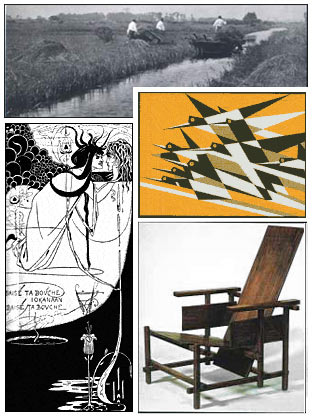
Perhaps the best way to start is with a quote from Richard
Saul Wurman’s book Access London, in which he describes
the Victoria and Albert Museum. He writes:
If
you have a curious
mind and a receptive heart, and if your like stuff, this
fascinating institution will become one of your favorite
places on earth. It is one of the most addictive and rewarding
museums in the world, covering 12 acres with items of enchantment
and delight.
This large museum in South Kensington is home to one of
the largest collections of decorative art objects in the
world. It also is home to resident scholars.
back to top
THE BRITISH
LIBRARY
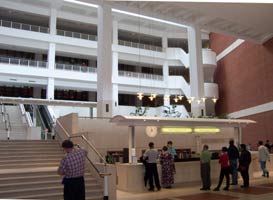 http://www.bl.uk/
http://www.bl.uk/
One of the greatest resources is the British Library, which
holds a copy of every book ever published in English, going
back to the Middle Ages. It has the Lindesfarne Gospel,
books by Aldus Manutius, John Baskerville, and William Morris.
It is a research 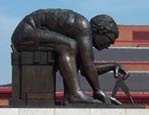 library
and readers must apply for a readers card, presenting evidence
of need to research in the Libary. Among their special collections
are special exhbits on sucht topics as the history of the
book, history of printing and and manuscripts.
library
and readers must apply for a readers card, presenting evidence
of need to research in the Libary. Among their special collections
are special exhbits on sucht topics as the history of the
book, history of printing and and manuscripts.
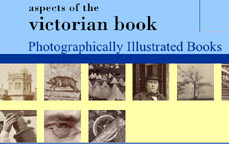
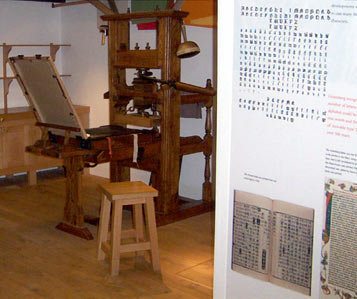
back to top
THE NATIONAL
ART LIBRARY
http://www.nal.vam.ac.uk
The National Art Library has a huge collection of books
and periodicals on and by artists. An extensive catalogue
of holdings is available on-line, allowing you to search
and request items before you leave for London. Special collections
include a book-arts collection, featuring one-of-a-kind
or limited edition books by artists, showing unique binding,
printing, and content.
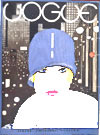
Extensive historic archives are available also, Currently
on their web site are informative surveys of a number of
relevant topics, such as "Selling Modernity–Art
Deco and the American Magazine Cover".
THE BRITISH
MUSEUM
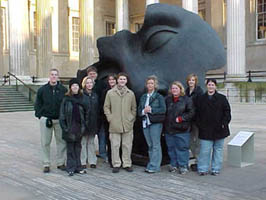
http://www.thebritishmuseum.ac.uk
The British Museum is located only a short walk from the
hotel and features exhibits of ancient through modern artifacts,
including the famous marble statues from the Parthenon,
the hoard so Sutton Hoo, and wonderful carvings from ancient
Persia and Asia.
back to top
THE DESIGN MUSEUM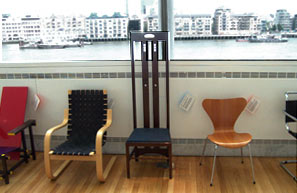
http://www.designmuseum.org/
This museum specializes in design - pure and simple. It
has changing exhibits of work by contemporary designers
as well as permanent displays of classic designs. It covers
graphic design, product design, interaction design. This
museum is located on the Thames in the Bankside area, with
great views of the Thames and the TowerBridge from its third-floor
gallery.
back to top
GEFFRYE
MUSEUM
http://www.geffrye-museum.org.uk
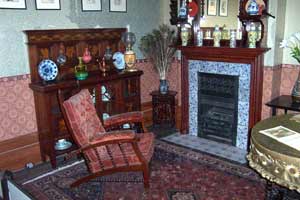 The
Geffrey Museum has an excellent survey of domestic interiors
from the 1500's to the present. Each is exhbited in the
context of the arts and production methods of the time.
The museum also contains an specialized reading room with
resources on furniture and interior styles .
The
Geffrey Museum has an excellent survey of domestic interiors
from the 1500's to the present. Each is exhbited in the
context of the arts and production methods of the time.
The museum also contains an specialized reading room with
resources on furniture and interior styles .
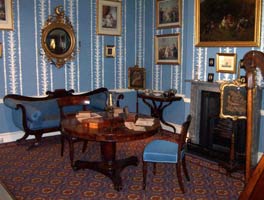
back to top
THE TATE MUSEUM
http://www.tate.org.uk/modern/
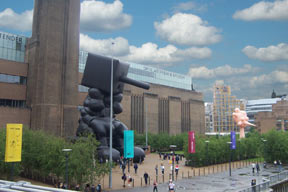
.
This is really two museums - the TATE BRITAIN and
the TATE MODERN. The Modern is perhaps the more interesting
of the two, located south of the Thame, the this museum
of contemporary and modern art is five very large floors
of a renovated power station.More devoted to fine art than
design, it is still worth visiting.
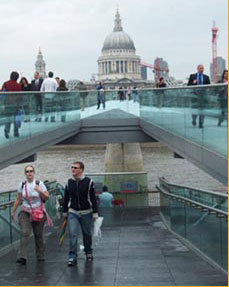
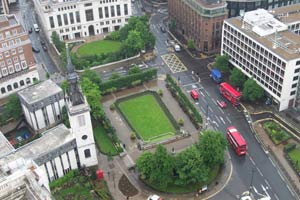 Logistically, it is convenient to combine a visit
to St. Paul's cathedral with a visit to the Tate Modern.
St. Paul's affords a wonderful panoramic view of London
from the top of its Dome. A foot bridge crosses the Thames
and puts you squarely in front of the Tate Museum which
is housed in a huge converted electric generating plant
Logistically, it is convenient to combine a visit
to St. Paul's cathedral with a visit to the Tate Modern.
St. Paul's affords a wonderful panoramic view of London
from the top of its Dome. A foot bridge crosses the Thames
and puts you squarely in front of the Tate Museum which
is housed in a huge converted electric generating plant
back
to top
THE TYPE MUSEUM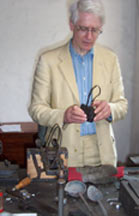
A museum-in-progress is the best way to describe the state
of the Monotype collection. Its best resource is the director,
Piers Rodgers, who is more than happy to demonstrate every
step of the process of making lead type. Here he shows how
to use a type mold - the kind that Gutenberg himself would
have found familiar. Director Rodges is well-versed in type
history and can tell you exactly what happened to John Baskerville's
original types.
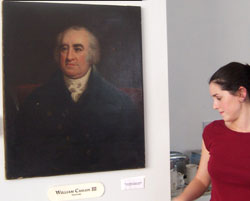
a portrait of type designer William Caslon III.
THE WILLIAM
MORRIS GALLERY
http://www.lbwf.gov.uk/wmg
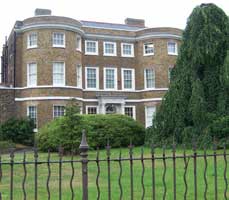 The
Gallery's internationally important collections illustrate
William Morris's life, work and influence. There are permanent
displays of printed, woven and embroidered fabrics, rugs,
carpets, wallpapers, furniture, stained glass and painted
tiles designed by Morris himself and by Edward Burne-Jones,
Philip Webb, Dante Gabriel Rossetti, Ford Madox Brown and
others who together founded the firm of Morris, Marshall,
Faulkner & Company in 1861.
The
Gallery's internationally important collections illustrate
William Morris's life, work and influence. There are permanent
displays of printed, woven and embroidered fabrics, rugs,
carpets, wallpapers, furniture, stained glass and painted
tiles designed by Morris himself and by Edward Burne-Jones,
Philip Webb, Dante Gabriel Rossetti, Ford Madox Brown and
others who together founded the firm of Morris, Marshall,
Faulkner & Company in 1861.
back
to top
DESIGN STUDIO VISITS
Intro Design (Adrian Shaunessey – principle designer)
 "Intro
Design" is one of london'is leading design studios,
serving clients in the entertainment and financial sectors.
It is situated just a short walk from the Hotel, near the
British Museum. Employing about ten people in graphics,
writing and multimedia, the firm has made a name for itself
designing for the music industry. This requires keeping
in close touch with trends in popular culture.
"Intro
Design" is one of london'is leading design studios,
serving clients in the entertainment and financial sectors.
It is situated just a short walk from the Hotel, near the
British Museum. Employing about ten people in graphics,
writing and multimedia, the firm has made a name for itself
designing for the music industry. This requires keeping
in close touch with trends in popular culture.
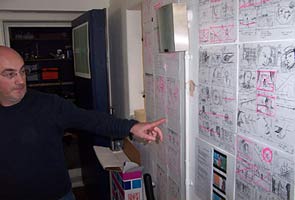 During a recent visit in May,
I noticed a wall covered with sketches. I asked about this
and Adrian Shaunessey, one of the principle designers, underscored
the need to plan carefully on paper before working on the
computer as a way of saving time and effort.
During a recent visit in May,
I noticed a wall covered with sketches. I asked about this
and Adrian Shaunessey, one of the principle designers, underscored
the need to plan carefully on paper before working on the
computer as a way of saving time and effort.
back
to top
Milk Communications:Dave Smith – Principle Designer
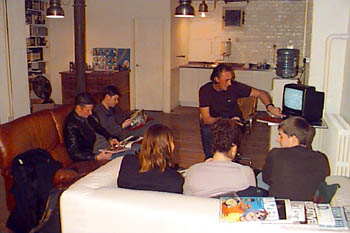
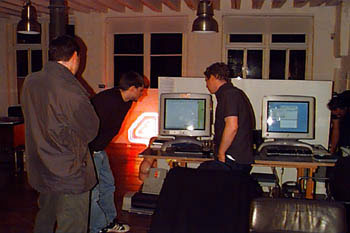
In
January 2001 the multimedia class in London visited Dave
Smith at his studio and heard him discuss a series of televison
commericals and ba coffee table book he was working on for
Nike. This summer, when
I visited him, he had just returned from Prague where he
was researching an article for the British design press
on the state of design in the former eastern block countries.
back
to top

